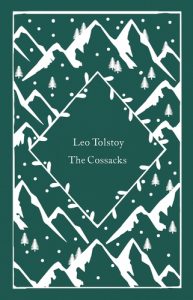I blame Jermyn Street Theatre. I was early for a show there recently (review job) and the doors weren’t open. So I retreated to the warmth of Waterstones round the corner in Piccadilly. There, I spotted a new, very appealing brand line from Penguin – Little Cloth Bound Classics. I chuckled as I browsed. Penguin famously pioneered pocket sized paperback books in the 1930s in order to make reading more affordable and portable. Has it now gone full circle?
Naturally I bought one. And chuckled again. The Cossacks dates from 1863. It was styled as a short story and Penguin has previously presented it in a fat volume with other stories. Well “short” is a misnomer and I’d defy anyone to read it one sitting. In this edition it runs to 261 pages. I suppose by then Tolstoy had already written his “loose baggy monster”, as Henry James called War and Peace which was published eight years earlier. Once you’ve written a novel of nearly 600k words your concept of “short” is bound to have shifted a bit.
Dmitry Andreich Olenin is a wealthy aristocrat who has tired of the shallowness of Moscow life. He therefore goes as an officer cadet to the Caucasus to assist the Cossacks in their war against the Chechens. There he meets a girl named Maryana and is very taken with her beauty, naturalness and verve but she’s committed to marry a local boy. There is no happy ending for any of them.
Tolstoy is very good at evoking life in the remote Caucasus – at times it reads like notes for a TV documentary. These people live in what translator David McDuff gives as “settlements” as opposed to villages although they seem to have everything they need such as guns, horses and material to make new clothes for festival days. They hunt a lot in woodland which seems to be rich with game and make their own very potent wine chikhir from their abundant vineyards. Olenin is billeted with one of the families and we see most of this from his point of view. It is exotically attractive to him and remote, in every sense, from Moscow.
Tolstoy has based much of this – the picture he paints of the scenery is good too – on his own experience of serving in the Crimea. He subtitles it “a Caucasus tale of 1852”. There’s a great deal of drinking, shooting and wistfulness.
Of course I have read Tolstoy before although I much prefer Anna Karenina, which I have enjoyed five or six times, to the Loose Baggy Monster. Written in the 1870s when Tolstoy was a mature man in his fifties Anna Karenina is much more measured and grown up than War and Peace which was published two decades earlier. It’s half the length too. I didn’t, however, know much about his “short” fiction which I shall now explore further.

Next week on Susan’s Bookshelves: The Virgin Suicides by Jeffrey Eugenides